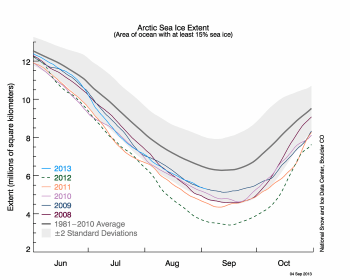Arctic Sea Ice Recovering from Last Year's Record Low
- OurStudio

- Sep 9, 2013
- 3 min read
Erectus: Dreamstime
Over the weekend, The Daily Mail reported that there has been a record "return" of Arctic sea ice over this past summer, i.e., less of it melted than it did last year. From the Mail:
A chilly Arctic summer has left nearly a million more square miles of ocean covered with ice than at the same time last year – an increase of 60 per cent. The rebound from 2012's record low comes six years after the BBC reported that global warming would leave the Arctic ice-free in summer by 2013. Instead, days before the annual autumn re-freeze is due to begin, an unbroken ice sheet more than half the size of Europe already stretches from the Canadian islands to Russia's northern shores.
What is going on? The National Snow and Ice Data Center reports:
Sea ice extent for August 2013 averaged 6.09 million square kilometers (2.35 million square miles). This was 1.03 million square kilometers (398,000 square miles) below the 1981 to 2010 average for August, but well above the level recorded last year, which was the lowest September extent in the satellite record. Ice extent this August was similar to the years 2008 to 2010. These contrasts in ice extent from one year to the next highlight the year-to-year variability attending the overall, long-term decline in sea ice extent.
The 2013 Arctic sea ice trend is still below the 1981 to 2010 average as illustrated below:

NSIDC
In any case, back in 2007 the BBC did report alarmist climate computer model projections that Arctic sea ice could be completely gone by this year:
Professor Wieslaw Maslowski told an American Geophysical Union meeting that previous projections had underestimated the processes now driving ice loss. Summer melting this year reduced the ice cover to 4.13 million sq km, the smallest ever extent in modern times. Remarkably, this stunning low point was not even incorporated into the model runs of Professor Maslowski and his team, which used data sets from 1979 to 2004 to constrain their future projections. "Our projection of 2013 for the removal of ice in summer is not accounting for the last two minima, in 2005 and 2007," the researcher from the Naval Postgraduate School, Monterey, California, explained to the BBC. "So given that fact, you can argue that may be our projection of 2013 is already too conservative." … "My claim is that the global climate models underestimate the amount of heat delivered to the sea ice by oceanic advection," Professor Maslowski said. "The reason is that their low spatial resolution actually limits them from seeing important detailed factors. "We use a high-resolution regional model for the Arctic Ocean and sea ice forced with realistic atmospheric data. This way, we get much more realistic forcing, from above by the atmosphere and from the bottom by the ocean."
Last week, 18 teams of climatologists reported in the Bulletin of the American Meteorological Society their efforts to tease out of various data the effect that man-made global warming had on 12 different weather extremes in 2012. The National Oceanic and Atmospheric Administration summarized the BAMS findings on Arctic sea ice trends as:
The extremely low Arctic sea ice extent in summer 2012 resulted primarily from the melting of younger, thin ice from a warmed atmosphere and ocean. This event cannot be explained by natural variability alone. Summer Arctic sea ice extent will continue to decrease in the future, and is expected to be largely absent by mid-century.
Perhaps. However, University of Wisconsin climate researcher Anastasios Tsonis and his colleagues believe that they have identified how the synchronization of large-scale climate phenomena like El Nino, the Pacific Decadal Oscillation and the North Atlantic Oscillation combine to produce dramatic shifts in global climate. Their research suggests that the these phenomena blended together in the 1970s to produce a warming regime and that they have now shifted back toward an overall cooling regime. If so, that might explain why there has been so little increase in global average temperatures over the past 15 years or so.




Comments